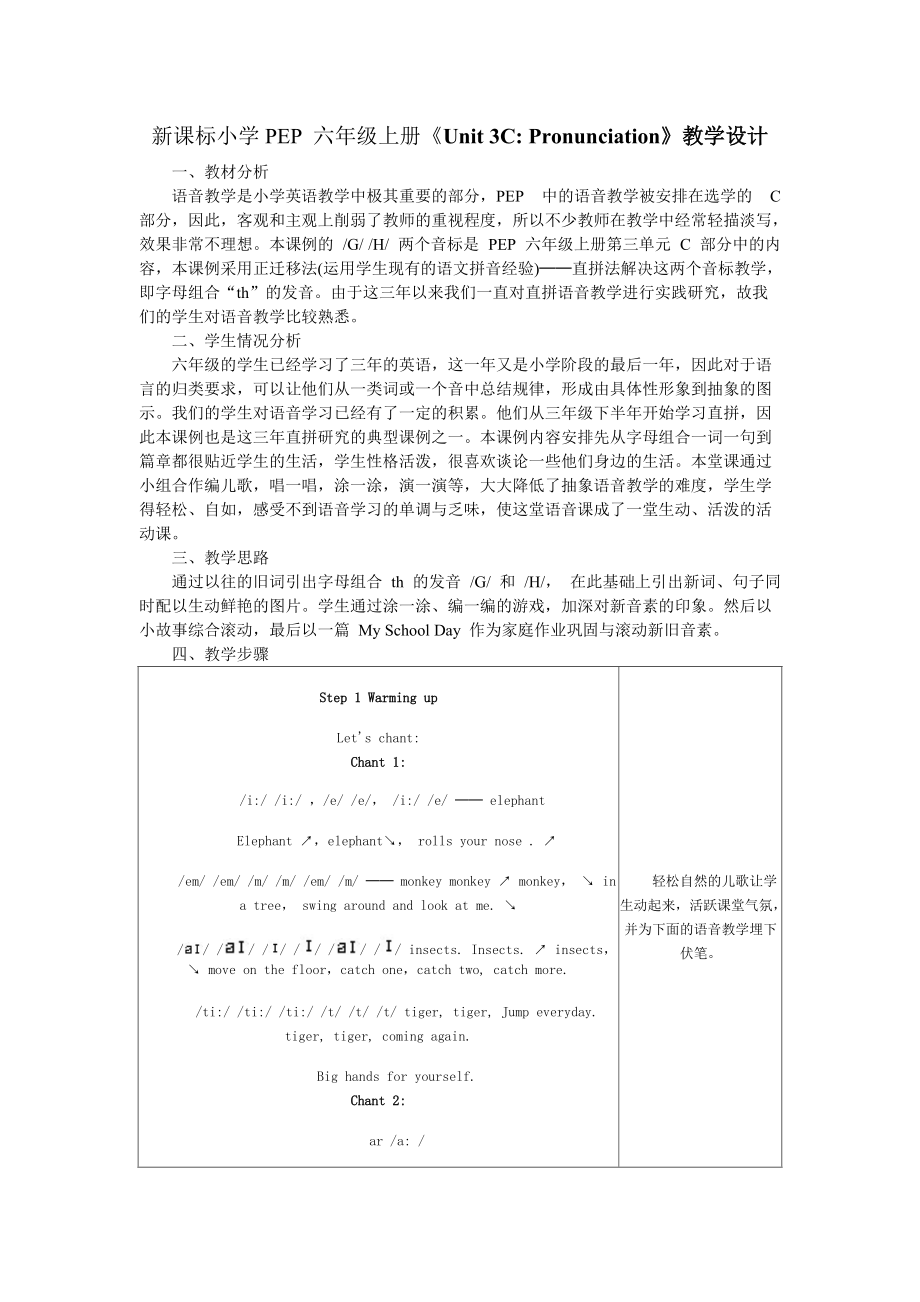《新課標(biāo)小學(xué)PEP 六年級(jí)上冊(cè)《Unit 3C Pronunciation》教學(xué)設(shè)計(jì)》由會(huì)員分享��,可在線閱讀,更多相關(guān)《新課標(biāo)小學(xué)PEP 六年級(jí)上冊(cè)《Unit 3C Pronunciation》教學(xué)設(shè)計(jì)(8頁(yè)珍藏版)》請(qǐng)?jiān)谘b配圖網(wǎng)上搜索�����。
1�����、
新課標(biāo)小學(xué)PEP 六年級(jí)上冊(cè)《Unit 3C: Pronunciation》教學(xué)設(shè)計(jì)
一����、教材分析
語(yǔ)音教學(xué)是小學(xué)英語(yǔ)教學(xué)中極其重要的部分,PEP 中的語(yǔ)音教學(xué)被安排在選學(xué)的 C 部分��,因此���,客觀和主觀上削弱了教師的重視程度����,所以不少教師在教學(xué)中經(jīng)常輕描淡寫�����,效果非常不理想����。本課例的 /G/ /H/ 兩個(gè)音標(biāo)是 PEP 六年級(jí)上冊(cè)第三單元 C 部分中的內(nèi)容,本課例采用正遷移法(運(yùn)用學(xué)生現(xiàn)有的語(yǔ)文拼音經(jīng)驗(yàn))──直拼法解決這兩個(gè)音標(biāo)教學(xué)�����,即字母組合“th”的發(fā)音���。由于這三年以來我們一直對(duì)直拼語(yǔ)音教學(xué)進(jìn)行實(shí)踐研究�����,故我們的學(xué)生對(duì)語(yǔ)音教學(xué)比較熟悉�����。
二�����、學(xué)生情況分析
六年級(jí)的學(xué)生已經(jīng)學(xué)習(xí)了
2�����、三年的英語(yǔ)���,這一年又是小學(xué)階段的最后一年����,因此對(duì)于語(yǔ)言的歸類要求��,可以讓他們從一類詞或一個(gè)音中總結(jié)規(guī)律����,形成由具體性形象到抽象的圖示。我們的學(xué)生對(duì)語(yǔ)音學(xué)習(xí)已經(jīng)有了一定的積累����。他們從三年級(jí)下半年開始學(xué)習(xí)直拼,因此本課例也是這三年直拼研究的典型課例之一���。本課例內(nèi)容安排先從字母組合一詞一句到篇章都很貼近學(xué)生的生活�����,學(xué)生性格活潑�����,很喜歡談?wù)撘恍┧麄兩磉叺纳睢1咎谜n通過小組合作編兒歌,唱一唱��,涂一涂�����,演一演等����,大大降低了抽象語(yǔ)音教學(xué)的難度,學(xué)生學(xué)得輕松�����、自如���,感受不到語(yǔ)音學(xué)習(xí)的單調(diào)與乏味����,使這堂語(yǔ)音課成了一堂生動(dòng)���、活潑的活動(dòng)課��。
三�����、教學(xué)思路
通過以往的舊詞引出字母組合 th 的發(fā)音 /G/ 和
3��、/H/����, 在此基礎(chǔ)上引出新詞、句子同時(shí)配以生動(dòng)鮮艷的圖片���。學(xué)生通過涂一涂��、編一編的游戲��,加深對(duì)新音素的印象��。然后以小故事綜合滾動(dòng)�����,最后以一篇 My School Day 作為家庭作業(yè)鞏固與滾動(dòng)新舊音素����。
四����、教學(xué)步驟
Step 1 Warming up
Lets chant:
Chant 1:
/i:/ /i:/ ,/e/ /e/���, /i:/ /e/ ── elephant
Elephant ↗��,elephant↘�����, rolls your nose . ↗
/em/ /em/ /m/ /m/ /em/ /m/ ── monkey monkey ↗ monkey�����, ↘ in a
4��、tree��, swing around and look at me. ↘
// // // // // // insects. Insects. ↗ insects����, ↘ move on the floor�����,catch one,catch two, catch more.
/ti:/ /ti:/ /ti:/ /t/ /t/ /t/ tiger, tiger, Jumpeveryday. tiger, tiger, coming again.
Big hands for yourself.
Chant 2:
ar /a: /
You can drive a car,
Runni
5���、ng on the road fast.
I can drive a star,
Flying in the dark.
al/:l/
Walk and talk,
Walk and talk,
Walk like a dog,
Talk with your friend.
輕松自然的兒歌讓學(xué)生動(dòng)起來��,活躍課堂氣氛��,并為下面的語(yǔ)音教學(xué)埋下伏筆����。
Step 2 Presentation and practice
1.th
課件第一次閃爍單詞:
this with their together the weather they clothes
T: What ca
6���、n you see?
(閃爍兩次直到學(xué)生說出單詞)
課件出現(xiàn)單詞���,并轉(zhuǎn)化 th 的顏色,以突出字母組合 th.
this with their together the weather they clothes
T: Here th is pronounced as...
Ss: /H/
T: Lets read together.
Ss: /H/ /H/ ──this
/H/ /H/ ──with
...
T: Can you give some other words?
S1: /H/ /H/ ──that
S2: /H/ /H/ ──father
S3: /H
7�����、/ /H/ ──other
...
T: Yes��,"th" is pronounced as/H/.
2.T: Can you try this?
(課件):leather
(Ss pronounce it together.)
S1: /l/ /e/ /H/ // ──leather
T: Look�����, this is...
(課件出現(xiàn)圖片 leather )
Ss: leather
T: (課件出現(xiàn)圖片 : feather )
Can you read it ?
(Ss pronounce the word together.)
/f/ /e/ /H/
8、// feather
S1: ...
S2: ...
Lets read the sentence together�����。(出示圖片)
Leather and feather, they are together.
T: Leather and feather...
Ss: They are together.
3. T: Lets read the sentence together.
(課件出現(xiàn)圖片和相對(duì)應(yīng)的句型: Leather and feather, they are together.)
Ss: Repeat the sentences.
S1: Leather
9����、 and feather, they are together.
S2: Leather and feather, they are together.
(課件呈現(xiàn))
th
math third month throat three thin through north
T: How about these words? Can you read them?
課件出現(xiàn)單詞�����,并轉(zhuǎn)化 th 的顏色�����,以突出字母 th.
math third month throat three thin through north
T: Here "th" is pronounced
10�����、as...
Ss: /G/
T: Lets read together .
Ss: /G/ /G/ math, /G/ /G/ third ...
( 課件逐個(gè)呈現(xiàn)各單詞��,學(xué)生讀課件上的單詞��。)
4.T: Can you give me some other words?
S1: /G/ /G/ south,
S2: /G/ /G/ think,
S3: /G/ /G/ path,
(課件呈現(xiàn)) moth
T: Can you try this?
(Ss pronounce it together.):/m/ /:/ /G/ moth
T: Look, this
11�����、is...
T: How about this one?
earth
(Ss pronounce it together.)
T: How about this one?
Thirsty
(同法教學(xué) thirsty和 earth。)
5.T: Now, lets make the sentence about these words.
A thirsty moth is in the earth.
6.T: Lets read the sentence together.
(課件出現(xiàn)圖片和相對(duì)應(yīng)的句型: A thirsty moth is in the
12����、earth.)
Ss repeat the sentence.
T: Can you say some other sentences like this?
S1: Thin moth, fat moth, up and down.
S2: A thirsty moth is sitting on the earth, counting the moths.
S3: A thirsty moth is sitting on the earth, counting the moths, thinking of the earth.
S4: The moth is thin, the
13、earth is thirsty.
S5: Look at the moth, sitting on the earth, thinking of math.
7.T: Now, look! How many moths can you see?
(課件)
Ss: There are three moths.
T: What do they do?
They travel through the desert.
Three moths left home to travel north through the desert.
T: What clothes did they
14����、wear?
Why?
They wore thin clothes because the weather was hot.
T: What did they do?
Their throat were dry so they drank thirstily from the water bags.
T: Why did they wear the leather shoes?
Their leather shoes protected their feet from the beat of the earth.
T: When did the story happ
15、y?(課件)
On the third day of the month.
8.T: Yes, this is a story about three moths. On the third day of the month. Now lets enjoy the story together.
(課件依次呈現(xiàn)整個(gè)故事���。)
9.The students read the story together.
10.Let students act out the story.
課件閃爍�����,引起學(xué)生的興趣���,使學(xué)生注意力集中,同時(shí)培養(yǎng)學(xué)生快速記憶的能力���。
對(duì)發(fā)音進(jìn)行歸類����。
16、
促使學(xué)生回憶以往語(yǔ)音���,給語(yǔ)音進(jìn)行歸類���,有利于學(xué)生記憶能力的發(fā)展。
培養(yǎng)學(xué)生的探究能力�����。
把枯燥的語(yǔ)言教學(xué)轉(zhuǎn)化為活潑有趣的詞匯教學(xué)����。
鮮艷的圖片刺激學(xué)生的多種感觀���,加深了印象���,豐富了想象,更讓他們置身其中����,其樂融融。
學(xué)生自編 chant,培養(yǎng)了學(xué)生的想象能力����,同時(shí)提高了學(xué)生綜合運(yùn)用語(yǔ)言的能力。
17�����、
逐漸呈現(xiàn)故事��,易于學(xué)生理解���。
通過故事表演���,加深對(duì)語(yǔ)音的印象,對(duì)文章的理解��。
Step 3 Homework
Read another story after school.(見附件�����。)
教學(xué)反思
本課例的設(shè)計(jì)緊密聯(lián)系學(xué)生的現(xiàn)有生活經(jīng)驗(yàn)����,活動(dòng)形式富有童趣���,符合小學(xué)生心理特點(diǎn),打破了以往的思維定式──語(yǔ)音教學(xué)單調(diào)����、乏味、學(xué)生厭學(xué)���、效率低��。本課例通過直拼法的設(shè)計(jì)��,把語(yǔ)音課上成活潑����,饒有趣味的活動(dòng)課���。如唱一唱,涂一涂����,編一編,演一演��,學(xué)生并沒有感到單調(diào)厭煩,反而是輕松自如��,效率很高�����。直拼式語(yǔ)音教學(xué)����,也
18、可以和詞匯課���、句型課一樣上得生動(dòng)活潑��、輕松自如����,讓學(xué)生也樂學(xué)�����、善學(xué)���。
附件 1
On the third day of the month, Three moths left home to travel north through the desert. They wore thin clothes because the weather was hot. Their throat were dry so they drank from the waterbags. Their leather shoes protected their feet from the beat of the
19��、 earth. They are tired but happy!
附件 2
Homework:
My School Day
Hello! My name is Gao Fei. I am thirteen. I study in a primary school.
This is my school day:
I get up early in the morning. Then I wash my face and brush my teeth.
I go to school at six thirty. Li is my neighbour. We are in the s
20��、ame school. We are good friends and we go to school together every day.
Our school is a little far away, so we go there by bike.Li rides faster than me.
Our school is beautiful. There is a big garden in front of the main building. We have different rooms, such as art room��, music room��,computer room��, and TV room. Classes begin at eight. We have four lessons every morning and three in the afternoon. Classes are over at five. After school we clean our classroom. Then we go home.
 新課標(biāo)小學(xué)PEP 六年級(jí)上冊(cè)《Unit 3C Pronunciation》教學(xué)設(shè)計(jì)
新課標(biāo)小學(xué)PEP 六年級(jí)上冊(cè)《Unit 3C Pronunciation》教學(xué)設(shè)計(jì)

